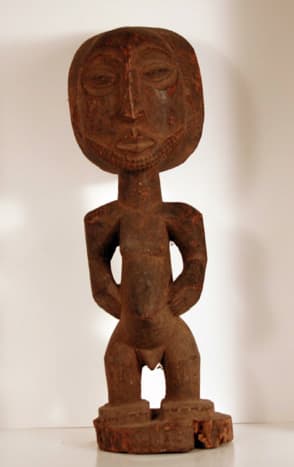Hemba Wooden Ancestor Figure, 20th Century CE
Wood
height 61 cm
height 24 in
height 24 in
PF.1466A
Standing figurine of a bearded man on a round platform, his hands aligned on the belly, the mouth slightly open, eyes half cast, the back of the head elaborately carved...
Standing figurine of a bearded man on a round platform, his hands aligned on the belly, the mouth slightly open, eyes half cast, the back of the head elaborately carved with a cruciform intaglio pattern. The back rendered flat apart from the bulging curves of his buttocks. The Hemba, living northeast of the Luba and once classed as a Luba subgroup, are now recognized as a distinct people. They are known particularly for the large and elegant male figures that represent ancestors. The great sculptures of wood were kept in the houses of clan chiefs as symbols of the dependence of the living upon the dead. Ancestral worship is the fabric of Hemba's society, which is based on clans, (sometimes comprising an entire village), often sharing a single ancestor. Hemba are proud of their clan history, and maintain genealogical trees to verify ownership of land and establishment of hierarchy. The chiefs are in charge of the ancestral figures as symbols of authority and objects of veneration. Thus, this handsome statue probably resided with a chief and formed an important part of the household, both in the secular and sacred sense. The style is typical of singiti figures--usually male, beautifully symmetrical and balanced, with extended abdomen, arms brought over the stomach, and a stylized beard. It exhibits those qualities the Hemba admired, giving the impression he has just come to rest, briefly, before continuing on, like a warrior or hunter. He is very human in the superb facial detail and richly designed headdress. Yet, he possesses an otherworldly aspect, as if he has walked out of the wood he was carved from. He exudes something not of this world, which is both beautiful and mysterious. One of the most attractive features are the half-closed eyes, which gives the figure a meditative quality, as if he is about to whisper something of great importance, or reveal a mystery from the other world. The nobility of this statue is derived from the masterful carving of a talented sculptor, and that indefinable something which makes an object a work of art.
By highlighting and intensifying only the important elements and eliminating the unessential, a dynamism of spirit and power results. Here, the body is sculpted in such a way as to highlight the abdomen. By exaggerating its size and flanking it with the figure's naturalized hands, the sculptor forces our focus upon the area of the human form that signifies a spiritual link between all members of one lineage, a result of the abdomen's unique relationship with the umbilical cord. Through sensitive and artistic abstraction of form, this male ancestor figure truly generates a spiritual energy and power that reaches across time and culture, moving the beholder on a variety of levels, conscious and subconscious.
For comparable examples see: T. Phillips, Africa. The Art of a Continent, London, 1995: pp.292-294. - (LO.1003)
By highlighting and intensifying only the important elements and eliminating the unessential, a dynamism of spirit and power results. Here, the body is sculpted in such a way as to highlight the abdomen. By exaggerating its size and flanking it with the figure's naturalized hands, the sculptor forces our focus upon the area of the human form that signifies a spiritual link between all members of one lineage, a result of the abdomen's unique relationship with the umbilical cord. Through sensitive and artistic abstraction of form, this male ancestor figure truly generates a spiritual energy and power that reaches across time and culture, moving the beholder on a variety of levels, conscious and subconscious.
For comparable examples see: T. Phillips, Africa. The Art of a Continent, London, 1995: pp.292-294. - (LO.1003)
